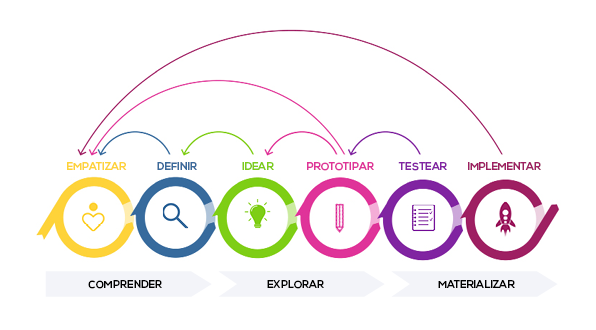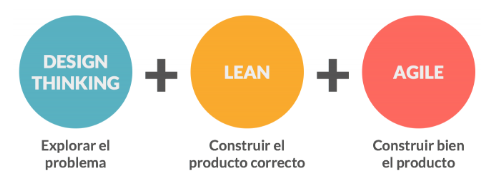90% of new companies develop non-viable projects that lead to failure.
The market is full of companies that meet customer needs.
You have to stand out from the others, but first check to see if your business idea will succeed.
To guarantee it, it is essential that you properly apply the techniques for the development of projects that will value their feasibility.
Words like Agile Methodology, Design Thinking and Lean Startup will surely ring a bell.
These methods have become role models within businesses to achieve the success of a business idea.
However, these practices often coincide in some respects and get confused frequently.
But don’t worry, that’s why we’re here. In this article, we will know each methodology and the main differences between them.
Let’s start!
The Agile Methodology deals with how to make and scale a solution.
It is based on the division of a project into several phases with short periods of time, called sprints, and breaks between them to analyze what has worked and determine the steps to follow.
The primary objective is to identify problems in time and change the route of the project if necessary.
In addition, it optimizes processes, as it facilitates the functions of work and decision-making.
It doesn’t matter at what stage of the process you are because there are mechanisms to adapt easily and end up getting a good final result.
Once you work and test each of the phases of this technique, you can scale the solution to get it up and running.
Therefore, the Agile Methodology uses tools and procedures to test hypotheses immediately.
The Design Thinking Methodology, or design thinking, addresses how to address a problem.
Through collective work and the use of creativity and empathy, innovative ideas are generated focused on the solution to a problem.
The aim is to use the skills of professionals to develop creative solutions that meet the needs of customers, and to turn them into tangible projects.
Many companies develop their new products by carefully analyzing a problem and creating possible solutions.
The Design Thinking is formed by several stages that do not have to follow a linear order, since it is useful to go forward or backward if you are interested.
The 5 stages to follow are:

Increasingly, solutions to problems are related to the digital environment.
A digital marketing strategy, positioning an e-commerce or the need for good web design and development can be creative solutions to your users’ problems.
Therefore, the Design Thinking Methodology aims to strike a balance between desire, need and the economic and technical feasibility of the project.
The Lean Startup Methodology deals with how to develop and test a solution.
By means of short and fast launch cycles, it creates Minimum Viable Products (MVP) of what is being worked.
It is an iterative process, as it is repeated until the final result is reached.
In this way, that solution to the problem is immediately prototyped and functionalities, desired objectives and reactions of our users can be verified.
The main objective is to quickly check the viability of a business idea.
Analyze and validate the variables that affect the proposed product or service while advancing the product to discover possible new improvements.
A technique without a specific time because it will end when the final result is given.
In addition, it runs from the creation of the product to the measurement of user response and the key elements of ultimate performance.
Therefore, a very useful methodology to build a suitable product or service and assess its feasibility.
The Agile, Design Thinking and Lean Startup Methodology have the common goal of understanding people’s needs and addressing the cycles and viability of an innovative idea.
In a changing environment with a high degree of competition, innovation is key to making your niche in the market.
By optimizing the capabilities and coordination of teams, these methodologies try to find the concrete solution to a specific problem.
They all focus on the end user and take the feedback very much into account.
Definitely, similar terms but with different functionalities and procedures.
Good project management is the basis for success.
To do this, you can use all these methodologies, but you have to know how to differentiate them and know which one can be most useful.
They all focus on reducing time and resources for the optimal development of a business idea.
However, the main difference is how to deal with the process and the elements that make it up.
The Agile Methodology focuses more on iterative development projects for the continuous re-evaluation of an idea while Design Thinking and Lean Startup are used more for prototyping and hypothesis testing.
The difference between the latter two is at the moment of implementing the product in the innovation cycle.
The Design Thinking technique focuses on knowing the needs of consumers before developing a good product or service.
Instead, the Lean Startup method quickly builds a prototype to be presented to consumers and, through feedbacks, make modifications to find the final result.

These differences do not imply that they are exclusive methodologies.
Use several methods to test your business idea and get the most out of it.
Understand the Agile Methodology, Design Thinking and Lean Startup as a set of tools to give value to your innovation and ensure the success of your project.
What are you waiting for to put them into practice?
And if you are interested in reading more articles on topics related to web development, digital marketing or e-commerce, go to our blog.
You will love it!
If you want to have the website you want or increase the online visibility of your brand, we know how to do it.
Shall we start today?
Leave a Reply